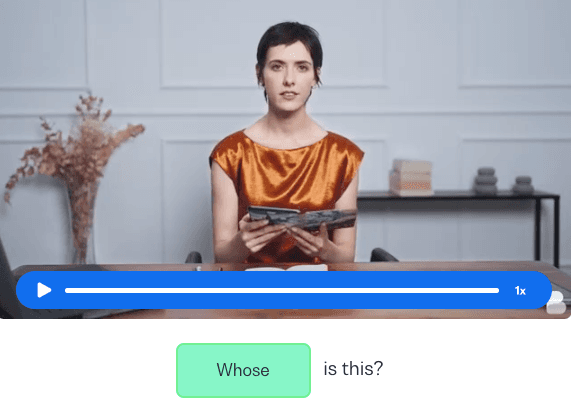I want to learn...
Author:

Chiara Pegoraro
Did you know that using relative pronouns will make your English sound more natural? Relative pronouns allow you to connect clauses and provide extra information. They are an essential part of language.
Relative pronouns can be tricky at times, but with this guide there will be no more secrets. Read this article to learn all there is to know about relative clauses and relative pronouns, including what they are, how to use them and how to avoid the most common mistakes.
What are relative pronouns?
Relative pronouns are used to give more information about a noun in a sentence. Let’s take a simple sentence as an example:
The teacher is very kind.
This is a good sentence, but it is not clear which teacher we are talking about. If you want to add more information about the teacher, you can add a relative pronoun, like who or that:
The teacher who helped me with my homework is very kind.
You can see that we added the words ‘who helped me with my homework’ to the sentence. These words are called a relative clause. A relative clause always begins with a relative pronoun and adds specific information about a person or thing in the sentence.
Another way to think about relative pronouns is that they connect two related sentences. Look at the following sentences:
A teacher helped me with my homework. She is very kind.
I borrowed a book from the library. It is very interesting.
A famous artist created this painting. It is very valuable.
Although short sentences are quite common in English, having so many would make the text look childish and oversimplified. It could easily sound as if the speaker is treating the listener like a small child. To fix this problem, we can combine the sentences using relative pronouns. The sentences below do just that. The relative pronouns are marked in bold.
The teacher who helped me with my homework is very kind.
The book that I borrowed from the library is very interesting.
The painting, which was created by a famous artist, is very valuable.
Using relative pronouns will make your speech and writing flow effortlessly, and it will add nuance and express more information to your listener or reader.
Relative pronouns can be the subject or object of a relative clause. They can also show possession. The table below lists the English relative pronouns based on their function in the sentence and on whether they can refer to people, animals or both.
Table of relative pronouns
| Subject | Object | Possessive | |
|---|---|---|---|
| About people | who | whom or who | whose |
| About objects | which | which | whose |
| About people and objects | that | that | whose |
Let’s look at a few examples for each type of relative pronoun.
Subject relative pronouns
Relative pronouns can act as the subject of relative clauses and provide additional information about a noun. Just as a reminder, the subject of a clause is the person or thing that does the action described by the verb. So in the sentence, “The boy plays the piano,” the subject is ‘the boy’ since he is doing the action (playing the piano) in the sentence. Take a look at the sentence below:
The boy who plays the piano is very talented.
You might think of this sentence as a combination of two simpler sentences – “The boy is very talented” and “The boy plays the piano.” The relative pronoun who replaces ‘the boy,’ which is the subject of both sentences. Therefore, ‘who’ is a subject relative pronoun in the full sentence.
Here are some more examples of subject relative pronouns in sentences:
The car which was parked outside has been towed.
The movie that won the award was fantastic.
The student that gets the highest score will receive a scholarship.
Object relative pronouns
You might remember that an object in grammar is the person or thing toward which the action of a verb is directed. So in the sentence “Jimmy eats an apple,” the action is ‘eats’ and the object is the thing that Jimmy eats – ‘an apple.’
The following sentences show some examples of object relative pronouns:
The professor whom you emailed will respond soon.
The professor who you emailed will respond soon.
The movie which we watched last night was fantastic.
The student that I tutored passed the exam.
The phone that she bought is already broken.
As we can see in the first two examples, both who and whom are correct when the object is a person. What is the difference, then? In informal speech we often use who, while whom is usually found in formal speech like business English, formal letters, official announcements or academic lectures.
Possessive relative pronouns
A possessive pronoun indicates, well… possession, or ownership of something. Look at the bolded words in the sentences below and see how they link together parts of the sentence:
I met a writer whose books have won several awards.
The company whose shares are rising is doing really well
As you can see, whose connects the books with the writer (it basically means his or her books) and the shares to the company (its shares). In shorter sentences like the examples above, this construction can seem forced and unnecessarily complicated, but it makes more sense in a written, formal paragraph.
Types of relative clauses
As we mentioned earlier, relative pronouns introduce relative clauses to give more information about a person or thing in a sentence. There are two main types of relative clauses – restrictive and non-restrictive clauses. Each one gives a different type of information. Let’s explore the difference between these two types to see how this difference is important.
Restrictive clauses
Restrictive clauses are sentences that provide necessary information to define or identify a noun. Look at these examples:
The man who just called is my brother.
The book which is on the table is mine.
See? In the first sentence, the relative clause ‘who just called’ tells which man we are talking about. If we just said “The man is my brother,” it would not be clear which man we were talking about. The relative clause tells the listener exactly who we mean.
In the same way, in the second sentence, the relative clause ‘which is on the table’ specifies which book we mean. If we just said “The book is mine,” this might not be clear.
Non-restrictive clauses
A non-restrictive clause, though, provides information that is not essential to identifying the person or thing mentioned in the sentence. Usually these sentences are separated from the main clause by commas, as in the following examples:
My brother, who lives in New York, is visiting us next week.
Big Ben, which is in London, is a famous landmark.
If you look at these sentences, you’ll notice that they can stand even without the relative clause:
My brother is visiting us next week.
Big Ben is a famous landmark.
So non-restrictive relative clauses add extra information to the sentence, but they are not necessary for understanding which person or thing we are talking about.
That, which or who?
We’ve already said that sometimes using the word whom can seem odd in informal communication. We can say the same about which and who in restrictive clauses. Take the examples we had before:
The man who just called is my brother.
The book which is on the table is mine.
In an informal, spoken conversation, these might sound a little odd to a native speaker. Much more common are these sentences:
The man that just called is my brother.
The book that is on the table is mine.
That often substitutes for who and which in informal communication but only in restrictive clauses.
It’s also important to remember that consistency is key. Don’t think that, as they are both correct, you can switch from one form to the other whenever you want. Is your text a formal piece of writing? Go with which and who. Are you talking to a friend about your life, movies or gossip? Your relative pronoun will be that.
Common mistakes
We’ve covered a lot of ground already but before we go, let’s take a look at the most common mistakes with relative pronouns.
Using who for objects
Incorrect: The book who is on the table is mine.
Correct: The book that is on the table is mine.
The book which is on the table is mine.
Remember that who is used only for people, and also sometimes for beloved house pets. It’s never used for objects.
Using which for people
Incorrect: The teacher which gave the lecture is very funny.
Correct: The teacher that gave the lecture is very funny.
The teacher who gave the lecture is very funny.
Remember –which is used only for objects and animals.
Using that in non-restrictive clauses
Incorrect: My brother, that lives in New York, is visiting us next week.
Correct: My brother, who lives in New York, is visiting us next week.
That should not be used in non-restrictive clauses, which provide additional information and are set off by commas.
Not using commas with non-restrictive clauses
Incorrect: Our holidays which we spent in Hawaii were unforgettable.
Correct: Our holidays, which we spent in Hawaii, were unforgettable.
Remember that non-restrictive clauses are separated from the main sentence by commas.
Wrapping up
Congratulations! You have now completed our comprehensive guide to relative pronouns. By mastering the use of who, which, that, and the other relative pronouns, you can make your English sound more natural and effortless.
If you follow the rules and guidelines that we’ve discussed, you will not only avoid common mistakes but also enhance your writing and speaking skills. As in all language learning, practice is key, so go and show off to the world your relative pronouns!
Enhance your language skills today!
You’ve just unlocked the secrets of relative pronouns, but there’s so much more to explore. Don’t let your language journey end here. With our app, you can work on all aspects of language learning, from using correct grammar to expanding your vocabulary. Let the learning continue today!
AUTHOR

Chiara Pegoraro
Newlanguages

